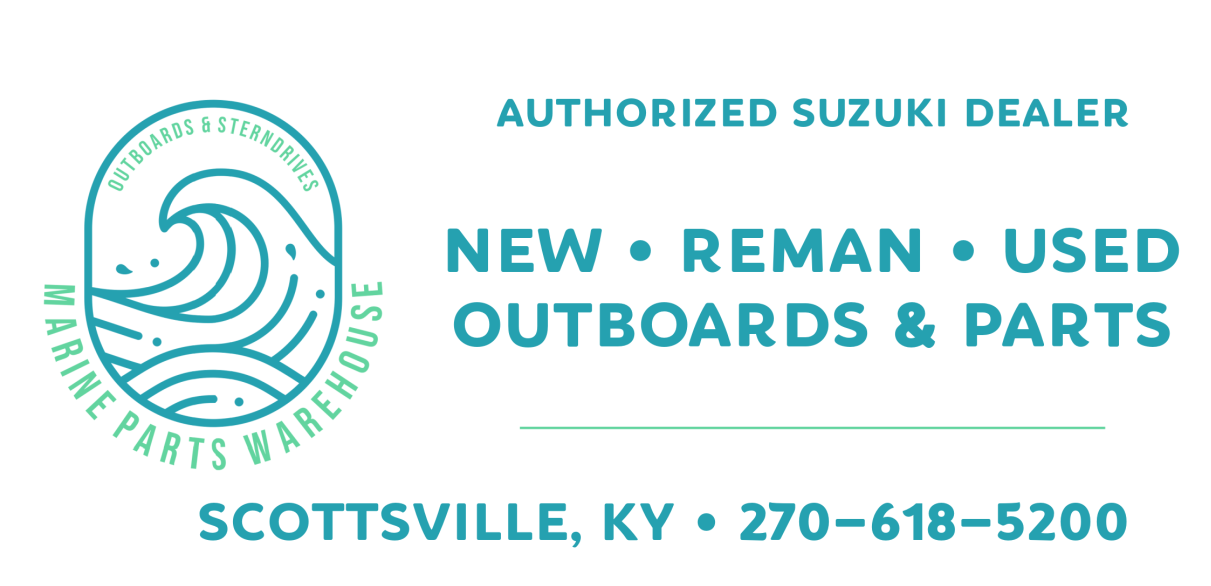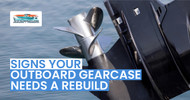10 Signs Your Outboard Gearcase Needs a Rebuild
You’re out on the water, family or friends on board, and your outboard starts making a noise you’ve never heard before. Maybe it’s a faint whining, maybe shifting feels rough, or you notice milky oil dripping when you pull the drain plug. In that moment, your heart sinks because you know the lower unit (gearcase) is the heartbeat of your motor.
The gearcase is the unsung hero of your outboard. It transfers all the horsepower from the engine down to the propeller, ensuring smooth, reliable motion. When it’s healthy, you hardly think about it. But when it starts to fail, even small warning signs can quickly escalate into costly breakdowns or, worse, being stranded on the water.
This guide highlights 10 clear signs your outboard gearcase may need a rebuild. We’ll look at what each symptom means, why it matters, and how you can check it yourself before deciding whether to rebuild, repair, or replace.
Sign#1: Milky, Foamy, or Discolored Gear Oil (Water Contamination)
Draining your lower unit oil is one of the simplest checks you can do, yet it reveals one of the most damaging problems: water intrusion. Healthy gear oil should look like clean motor oil, dark, smooth, and slick. But if what drains out looks like a milkshake, milky, cloudy, or foamy, you’ve got water contamination.
How to check?
- Remove the top vent plug first, then the bottom drain plug.
- Catch the oil in a clean, clear container.
- Examine closely for milky, emulsified fluid.
Why does it matter?
Water is a gearcase’s worst enemy. It strips away lubrication, corrodes gears, and encourages rust to form on bearings. Even if you don’t see chunks of metal, the simple presence of water means your seals have failed. Every time you run the engine, you’re grinding expensive parts together with little to no protection. If ignored, you’re not far from catastrophic gear failure. For boaters, that means not just repair bills, but ruined weekends and unexpected tow calls.
Sign#2: Metal Flakes or Heavy Magnetic Debris on Drain Plug / in Oil
Your drain plug usually contains a magnet that traps fine particles from natural wear. A light dusting of metallic powder is normal. But if you see shiny flakes, large chunks, or if the magnet looks like it grew a coat of porcupine quills, it’s a red alert.
What does it indicate?
- Gear wear from poor alignment or improper shimming.
- Bearings are breaking down and shedding metal.
- Circlip or retaining ring failure leading to grinding of components.
Why does it matter?
Metal shavings mean your gearcase is literally eating itself alive. Each flake or chunk represents a piece of metal that once belonged to a tooth, bearing, or clutch. Oil changes won’t fix this. Once debris appears, the only real option is a teardown and rebuild to prevent total lockup. For you, the boater, it’s the difference between catching the issue now or being stranded when the lower unit seizes at sea.
Sign#3: Grinding, Whining, or Gear-Chatter When Underway or When Shifting
Every experienced boater knows the solid “clunk” of shifting into gear. But when that sound is replaced with whining, grinding, or a chatter that rattles your hand on the controls, you’re hearing trouble inside.
Possible causes
- Worn clutch dog teeth slipping under load.
- Pitted or chipped gears in forward or reverse.
- Misaligned shims are causing incorrect gear lash.
Why does it matter?
Noise is your early-warning system. Gears don’t fix themselves, and once they start making noise, the damage only gets worse. Ignoring the sound can turn a rebuildable gearcase into a total replacement situation. More than that, it ruins your peace of mind on the water; you’ll spend every ride wondering if this trip is the one where the gear finally lets go.
Sign#4: Difficulty Shifting / Grinding When Engaging Gear
If sliding into forward or reverse feels stiff, sticky, or accompanied by a grinding delay, the issue goes beyond a simple cable adjustment.
Quick tests
- Try shifting at idle. If grinding happens despite proper adjustment, internal wear is likely.
- Disconnect the shift cables and move it manually. If it’s still stiff, the problem is inside the gearcase.
Why does it matter?
Hard shifts don’t just “go away.” Every forced engagement chews away at clutch dogs and gears. Left unchecked, it accelerates the failure process and ensures a rebuild will be needed sooner rather than later. For boaters, this means you’re gambling every time you slam it into gear, you may get on plane, or you may hear the dreaded crunch that ends your day.
Sign#5: Lower Unit Locks Up or Seizes When Spun by Hand
Spinning the prop by hand is a quick health test. In neutral, it should rotate freely. In gear, it should feel firm but smooth. A locked gearcase is one of the clearest signals that it’s time to repair a broken outboard gearcase. If it binds, catches, or won’t move at all, you’re facing a major problem.
Immediate action:
- Don’t run the engine.
- Tow or haul the boat out immediately.
- Forcing it risks total destruction.
Why does it matter?
A locked gearcase often means a seized bearing, shattered gear, or foreign debris wedged inside. Whatever the cause, the lower unit is already past the “warning” stage. A rebuild (at minimum) is unavoidable, and in some cases, replacement might be the only option. For the owner, this is the worst-case scenario, one that usually comes after smaller red flags were ignored.
Sign#6: Heavy Vibration or Shuddering at Certain RPMs / Bent Propeller
Every boater has felt the shake of a dinged prop, but if vibration persists after swapping or repairing your propeller, the cause might be deeper.
Check for:
- Prop blades that are bent or chipped.
- Wobble in the prop shaft is often a sign of worn bearings.
- Misalignment of gears transmitting uneven power.
Why does it matter?
Vibration isn’t just uncomfortable; it shortens the life of your entire drivetrain. What starts as a small imbalance spreads damage to seals, shafts, and gears. Addressing it early may save you from a full rebuild, but if ignored, the shaking is the gearcase’s way of begging for attention before a catastrophic failure.
Sign#7: Visible Oil Leaks from Prop Shaft Area or External Case Cracks
A little drip of oil might not seem like a big deal, but in a sealed system like a gearcase, even the smallest leak is a problem.
What to inspect?
- Prop shaft seals are often cut by fishing line.
- Drain/fill plug gaskets are cheap but critical.
- Housing cracks from grounding or debris strikes.
Why does it matter?
Leaks mean two things: oil getting out and water getting in. Both are equally destructive. Once the integrity of the case is compromised, it’s only a matter of time before lubrication breaks down and gears start to fail. What looks like a few drops on your driveway could be the start of a rebuild bill.
Sign#8: Loss of Top-End Speed or Difficulty Getting on Plane
Performance drop-offs often get blamed on fuel or propeller issues, but sometimes the hidden problem is the gearcase itself.
Possible causes
- Slipping gears that don’t fully engage under load.
- Bearing drag creates friction.
- Internal wear is affecting efficiency.
Why does it matter?
When your boat struggles to get on plane or feels sluggish, it’s frustrating and even unsafe if you’re caught in a strong current or bad weather. Performance loss is the gearcase’s subtle way of telling you something’s wrong internally. Fixing it early may save money and downtime, while ignoring it may leave you stuck offshore.
Sign#9: Unusual Smells (Burnt Oil) or Overheating Symptoms
If you catch a whiff of burnt oil near your outboard, your gearcase is cooking itself from the inside.
Why does it happen?
- Bearings are running dry from oil loss.
- Gears are grinding and creating friction.
- Oil is breaking down due to contamination.
Why does it matter?
Overheating isn’t just about temperature; it warps metal, hardens seals, and can seize bearings. By the time you notice the smell, the damage is advanced. This is one of those “don’t wait until next weekend” signs. Continued use almost guarantees a full rebuild or worse.
Sign#10: Corrosion, Pitted Anodes or Visible Housing Damage After Grounding/Impact
Impacts and corrosion don’t just leave scars on the outside; they compromise the whole unit.
When surface damage hides deeper problems?
- Saltwater corrosion eats seals and invites water inside.
- Impacts from grounding the bend shafts or cracking the housings.
- Anodes worn beyond 50% leave the gearcase defenseless.
Why does it matter?
Even if the outboard still “runs fine,” hidden internal damage could already be at work. That’s why mechanics pressure test after impacts, it’s the only way to be sure your seals are still holding. For boaters, ignoring corrosion or post-impact checks is a gamble that often ends in costly rebuilds.
FAQs
How do mechanics diagnose outboard gearcase problems?
Mechanics start with a visual inspection, then drain and inspect the oil. They’ll check for water, metal, and smell. Next, they test for shaft play, perform a pressure and vacuum test on seals, and, if needed, tear down the gearcase to inspect gears, bearings, and shims.
Should you rebuild, replace, or repair your gearcase?
It depends on the damage. Minor seal leaks can be repaired. Internal gear or bearing damage often requires a rebuild. If the casing is cracked or the cost of parts exceeds the value, replacing the lower unit may be more practical.
What happens during a typical outboard gearcase rebuild?
A mechanic will disassemble the gearcase, clean and inspect all parts, replace worn gears, bearings, and seals, re-shim the gears to factory tolerances, and reassemble with new oil. Pressure testing ensures no leaks before the motor goes back on the water.
How much does a gearcase rebuild cost, and how long does it take?
On average, expect $600–$1,500 for a rebuild, depending on parts and labor. Replacement lower units can cost much more. Turnaround time is usually one to two weeks, but it can stretch longer during peak boating season.
Is it worth rebuilding an outboard?
Yes, rebuilding an outboard is often worth it; it restores performance, extends lifespan, and saves money compared to full replacement.
Conclusion
Little warning signs now may turn into a major problem later, and that could leave you stranded without warning. Fixing a gearcase is not just repairing what’s damaged. It’s bringing back the confidence you need every time you head out. When these signals show up, act quickly before the damage grows.
Reach out to our team at 270-618-5200 for help made just for you. We’ll guide you through the repair and keep your adventures moving forward, and explore our outboard engine parts to get the quality marine parts for your boat.
Posted by Brian Whiteside


